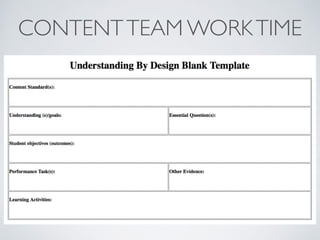This document provides an overview of Understanding by Design (UbD), a framework for designing curriculum, instruction, and assessment. It discusses the key concepts of UbD, including backward design, identifying desired results through essential questions, determining acceptable evidence of student understanding, and planning learning experiences. The document outlines the three stages of backward design and provides examples of how to write essential questions and develop assessments. It also emphasizes the importance of making learning meaningful and using technology to support differentiation. Overall, the document introduces educators to the UbD framework to help them design curriculum focused on developing student understanding.

























































